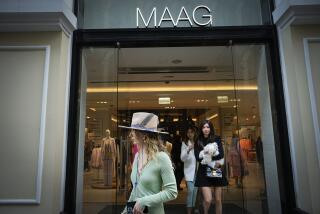Agencies Banking on Appeal of East Bloc in Ads
- Share via
NEW YORK — GE is bringing Eastern Europe to life.
For that matter, so are Pepsi, McDonald’s and Shearson Lehman Hutton. In fact, companies are jumping on the advertising bandwagon that portrays the East Bloc countries as rather happily falling under the magical spell of capitalism.
The latest is General Electric, which last Sunday morning tried to appeal directly to America’s opinion leaders and business executives by airing its East Bloc-themed commercial on such shows as “Meet the Press” and “This Week With David Brinkley.” The commercial, filmed in Hungary, portrays General Electric’s joint venture to manufacture light bulbs there as something no less historically significant than, say, McDonald’s hamburgers being sold near Red Square.
“We’re targeting the business executive,” said Barbara Parsky, manager of corporate advertising at General Electric. “The message here is that General Electric continues to undergo global expansion. This is, perhaps, our most dramatic example.”
The 30-second commercial is set to the music of “Hungarian Rhapsodies” and opens with a striking shot of late afternoon sunlight reflecting off the Danube River. A young man with a thick accent says: “Freedom’s all that matters. Freedom is everything.”
Lights seem to appear everywhere in the city as the sun slowly sets. “There’s a new light shining over Eastern Europe,” says an off-camera announcer, who briefly explains the venture between GE and Tungsram Co., one of Hungary’s largest light bulb makers. In November, GE purchased half of Tungsram for $150 million.
The commercial continues with a candlelight procession of people crossing a bridge as electric lights illuminate monuments and museums. The spot ends with the familiar slogan, “GE--We bring good things to life,” as a little girl lights a single candle.
To film the ad, GE spared few expenses. Although GE declined to reveal its production budget, industry executives say the commercial could have cost nearly $1 million to produce. It was created by the New York agency BBDO Worldwide, which also created an ad for Pepsi that aired during the Christmas season showing people celebrating at the dismantling of the Berlin Wall.
“Pepsi’s message was to the consumer. But the GE message is business to business,” said Ted Sann, executive creative director at BBDO. “Maybe we have jumped on a bandwagon with these ads. But these are events on the tops of people’s minds.”
Last October, an ad for Shearson Lehman Hutton aired during an ABC “Monday Night Football” game that showed signs of acceptance by some Communist consumers of capitalistic trends. One boy in an unspecified Communist nation is even seen skateboarding in a park behind a monument of the Communist Party symbol, the hammer and sickle. And a soldier from some East Bloc nation is seen munching a hot dog.
Recently, however, one New York agency brought the whole Eastern European advertising theme into perspective.
That agency, Deutsch Inc., produced an ad for a Swedish furniture maker, Ikea, that lampoons how “hip” the East Bloc themes have become.
In the ad, a snobbish woman is on the phone discussing her upcoming East Bloc-themed party. She orders a special caterer from Budapest. And she even requests a cake made to look like the Berlin Wall. Explains the woman to her friend: “Everyone will chip away at it with their forks.”
“We are living in the Golden Age of capitalism,” said Amil Gargano, chairman of the New York agency Ally & Gargano, which created the ad for Shearson Lehman Hutton. “A lot of people are embracing capitalism. And certainly Shearson Lehman can be influential in helping some people get into the free enterprise system.”
“These changes are so fundamental and so far reaching that it is not something that will go away,” said Gargano. “The question is: Who are the companies that will profit from this?”
Well, Levi Strauss & Co. has had a manufacturing facility in Hungary for years. But the company says that factory isn’t about to be the focus of any commercials. After all, most Levi ads are targeted toward teens. “This is not to say that teen-agers aren’t interested in what’s happening in Eastern Europe, but we usually go with something much closer to home,” said Dan Chew, marketing manager at Levi Strauss.
Meanwhile, Madison Avenue has also found ways to have some fun mixing the customs from two very different cultures. But the commercials haven’t always pleased everyone.
Who can forget the commercial Wendy’s ran several years ago that featured oversized Russian women parading around with flashlights and beach balls in an off-the-wall Russian fashion show? The ad was created by the New York agency Cliff Freeman & Partners.
At the height of the commercial’s popularity, a reporter from a New York TV station persuaded an official from the Soviet news agency Tass to watch the ad while the station’s cameras filmed his reaction. The official chuckled through the entire commercial, but when he was asked what he thought of the ad, he got very straight-faced and said it wasn’t funny.
“You can’t blame advertisers today for wanting to tap into the incredibly emotional situation in Eastern Europe,” said Cliff Freeman, chairman of the agency that made the ad. “But I still haven’t seen any ads that do it very well.”
More to Read
Inside the business of entertainment
The Wide Shot brings you news, analysis and insights on everything from streaming wars to production — and what it all means for the future.
You may occasionally receive promotional content from the Los Angeles Times.










